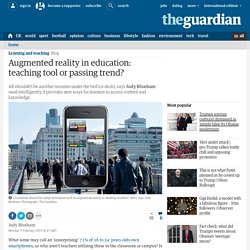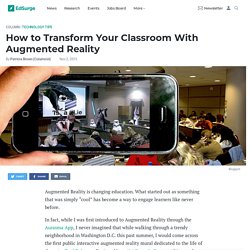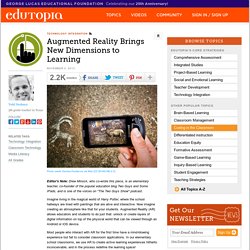

Tomas Morales
Augmented reality in education: teaching tool or passing trend? What some may call an 'unsurprising' 71% of 16 to 24-years-olds own smartphones, so why aren't teachers utilising these in the classroom or campus?

Is the use of these devices going to detract from the learning process or contribute to future workplace skills? Should teachers be using techniques such as augmented reality (AR) to engage students and develop their skills for the modern world? Well, I say 'yes'. I believe we should be embracing these opportunities. For instance I see AR as a real opportunity for colleges and universities, not only as a way to market and promote themselves, but as a way to communicate with learners and improve the student experience. AR allows people to add digital content to printed material, geographic locations and objects.
City University London have used a combination of techniques to develop resources through the CARE (Creating Augmented Reality in Education) project for healthcare students, including a series of 'health walks'. How to Transform Your Classroom With Augmented Reality. Augmented Reality is changing education.

What started out as something that was simply “cool” has become a way to engage learners like never before. In fact, while I was first introduced to Augmented Reality through the Aurasma App, I never imagined that while walking through a trendy neighborhood in Washington D.C. this past summer, I would come across the first public interactive augmented reality mural dedicated to the life of the actor Paul Robeson.
Designed by artist Corey L. Stowers, this mural allows viewers to scan and thus trigger images of his artwork with their mobile devices, accessing historical videos and original content that depict the life of the great athlete, performer, and civil rights activist. Augmented Reality in Education. Can augmented reality improve students’ learning? A proposal for an augmented museum experience. How can we improve learning and education through Augmented Reality? - Quora. WI2015 D 14 00036. EDUCATIONRadu et al. 5 reasons to use Augmented Reality in Education - Augment News.
By integrating augmented reality into your lectures, you’ll capture the attention of your audience.

You will have their undivided attention. For instance, a teacher in dentistry integrated Augment into his lessons to show 3D models of teeth and how the human jaw works. Let your audience participate! Students are able to access models on their own devices via Augment’s app. By viewing augmented models, the students can gain a better understanding of the concepts they are studying. Prototypes, physical models, and detailed illustrations and posters are all extremely expensive. With Augment, you do not have to invest in physical materials. With a simple a scan, students can access augmented models representing anything from a part of the human anatomy to a famous monument to a molecule. Incorporating Augment into your lessons will make your students excited about learning. Let student imagination runs wild! Download now the free Augment app on your iPhone, iPad or Android.
Augmented Reality Brings New Dimensions to Learning. Editor's Note: Drew Minock, who co-wrote this piece, is an elementary teacher, co-founder of the popular education blog Two Guys and Some IPads, and is one of the voices on "The Two Guys Show" podcast.

Imagine living in the magical world of Harry Potter, where the school hallways are lined with paintings that are alive and interactive. Now imagine creating an atmosphere like that for your students. Augmented Reality (AR) allows educators and students to do just that: unlock or create layers of digital information on top of the physical world that can be viewed through an Android or iOS device. Most people who interact with AR for the first time have a mind-blowing experience but fail to consider classroom applications. In our elementary school classrooms, we use AR to create active learning experiences hitherto inconceivable, and in the process redefine the learning space! Classroom Applications Not Just Another Fad There are endless ideas and possibilities for using AR.
AR. Augmented Reality Samples. How Augmented Reality Works. Video games have been entertaining us for nearly 30 years, ever since Pong was introduced to arcades in the early 1970s.

Computer graphics have become much more sophisticated since then, and game graphics are pushing the barriers of photorealism. Now, researchers and engineers are pulling graphics out of your television screen or computer display and integrating them into real-world environments. This new technology, called augmented reality, blurs the line between what's real and what's computer-generated by enhancing what we see, hear, feel and smell.
On the spectrum between virtual reality, which creates immersive, computer-generated environments, and the real world, augmented reality is closer to the real world. Augmented reality adds graphics, sounds, haptic feedback and smell to the natural world as it exists. Augmented reality is changing the way we view the world -- or at least the way its users see the world. What is Augmented Reality? Augmented reality is using technology to superimpose information on the world we see.

For example, images and sounds are superimposed over what the user sees and hears. Picture the "Minority Report" or "Iron Man" style of interactivity. This is rather different from virtual reality.